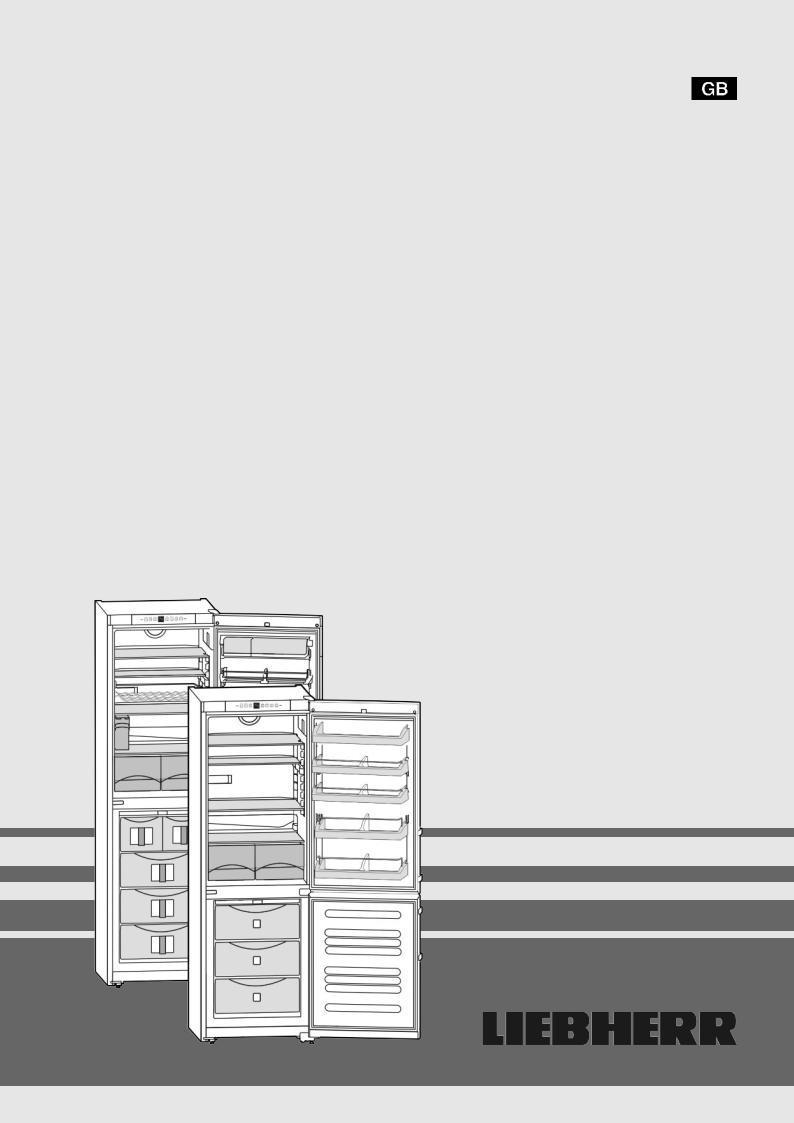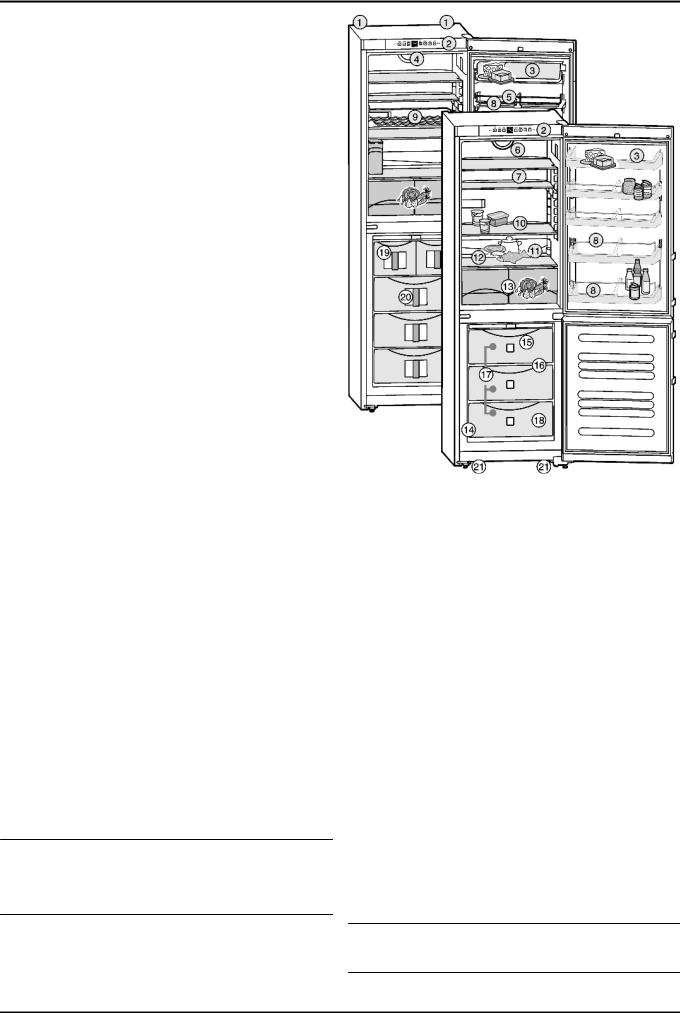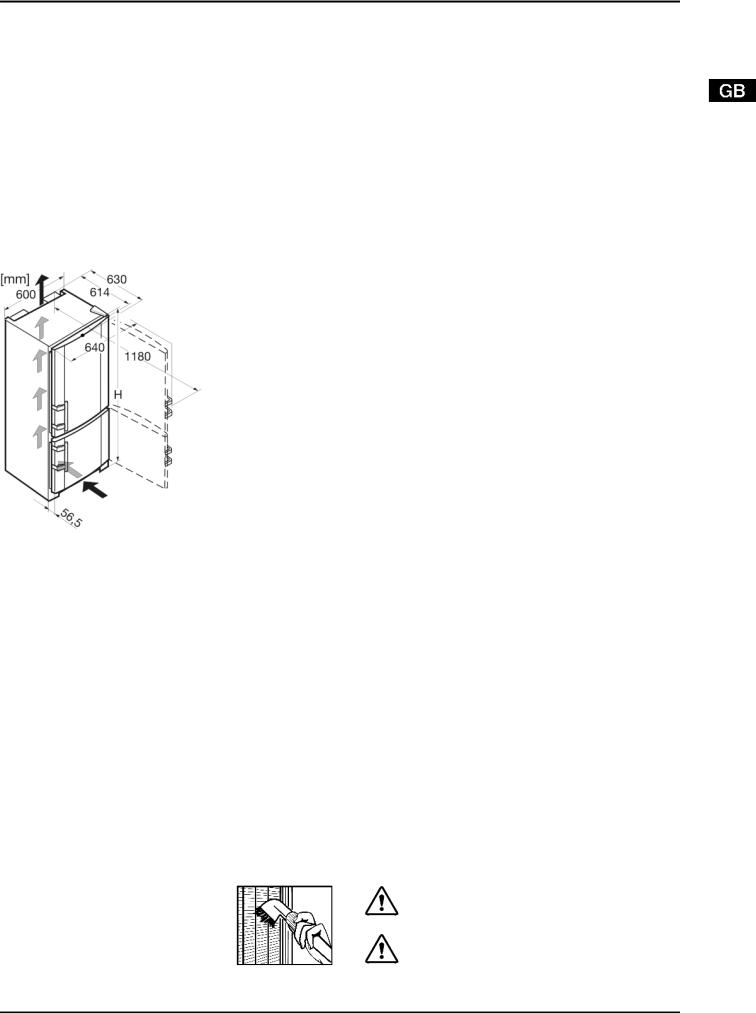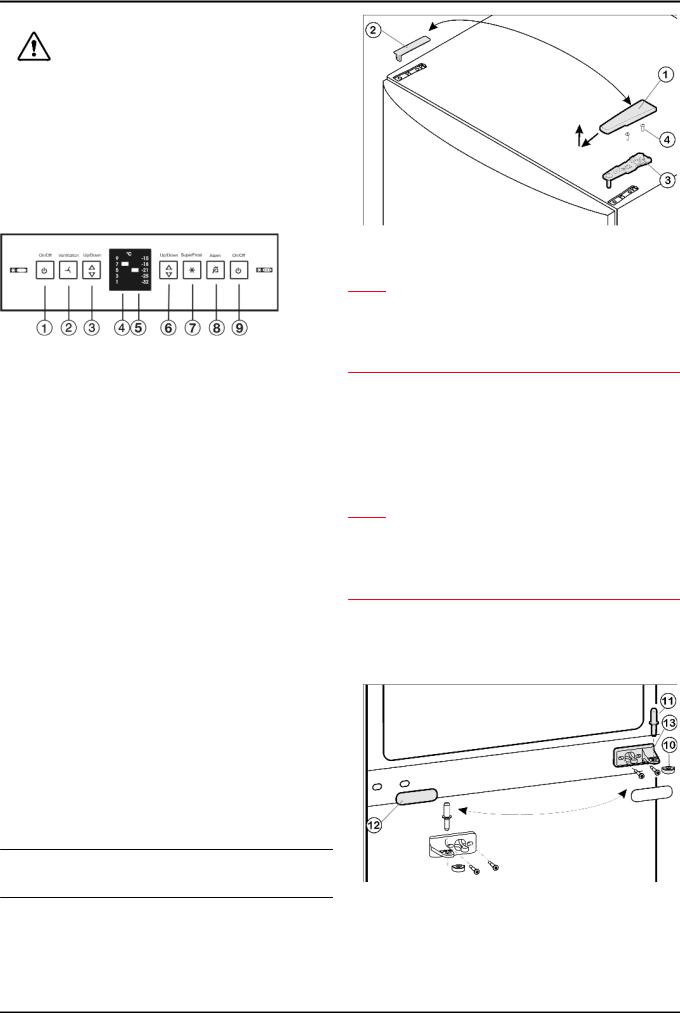Liebherr 7084376 - 03 User Manual

Operating instructions
Combined fridge-freezer
230610 7084376 - 03
CN(es) ... 3

Appliance at a glance
Contents |
|
|
1 |
Appliance at a glance............................................ |
2 |
1.1 |
Description of appliance and equipment.................. |
2 |
1.2 |
Range of appliance use............................................ |
2 |
1.3 |
Conformity................................................................ |
3 |
1.4 |
External dimensions of the appliance....................... |
3 |
1.5 |
Saving energy.......................................................... |
3 |
2 |
General safety information................................... |
3 |
3 |
Controls and displays........................................... |
4 |
3.1 |
Operating and control elements............................... |
4 |
3.2 |
Temperature display................................................. |
4 |
4 |
Putting into operation............................................ |
4 |
4.1 |
Changing over the door hinges................................ |
4 |
4.2 |
Insertion into a row of kitchen units........................... |
6 |
4.3 |
Transporting the appliance....................................... |
6 |
4.4 |
Installing the appliance............................................. |
6 |
4.5 |
Disposing of packaging............................................ |
7 |
4.6 |
Connecting the appliance......................................... |
7 |
4.7 |
Switching on the appliance....................................... |
7 |
5 |
Control.................................................................... |
7 |
5.1 |
Door alarm................................................................ |
7 |
5.2 |
Temperature alarm................................................... |
7 |
5.3 |
Refrigerator compartment........................................ |
7 |
5.4 |
Freezer compartment............................................... |
9 |
6 |
Maintenance........................................................... |
11 |
6.1 |
Defrosting with NoFrost............................................ |
11 |
6.2 |
Cleaning the appliance............................................. |
11 |
6.3 |
Cleaning the IceMaker............................................. |
11 |
6.4 |
Changing the interior light with bulb.......................... |
12 |
6.5 |
Customer service..................................................... |
12 |
7 |
Malfunction............................................................. |
12 |
8 |
Decommissioning.................................................. |
13 |
8.1 |
Switching off the appliance....................................... |
13 |
8.2 |
Taking the appliance out of service.......................... |
13 |
9 |
Disposing of the appliance................................... |
13 |
The manufacturer works constantly on the further development of all the types and models. Therefore please understand that we have to reserve the right to make design, equipment and technical modifications.
To get to know all the benefits of your new appliance, please read the information contained in these instructions carefully.
The instructions apply to several models. Differences may occur. Text relating only to specific appliances is marked with an asterisk (*).
Instructions for action are marked with a  , the results of action are marked with a
, the results of action are marked with a  .
.
1 Appliance at a glance
1.1 Description of appliance and equipment
Note
u Place food inside the appliance as shown in the diagram. This allows the appliance to save energy during operation.
u Shelves, drawers and baskets are arranged for optimum energy efficiency on delivery.
Fig. 1 |
(12) Coldest zone |
|
(1) |
Transport grips at back |
|
(2) |
Operating and control |
(13) Vegetable bin |
(3) |
elements |
(14) Type plate |
Butter and cheese |
||
(4) |
compartment |
(15) Cold storage accumula- |
Fan* |
||
(5) |
Door rack |
tors* |
(16) VarioSpace |
||
(6) |
Interior light |
(17) Freezer drawer |
(7) |
Shelf, sectioned |
(18) Ice-cube tray |
(8) |
Bottle holder |
(19) IceMaker* |
(9) |
Bottle shelf |
(20) Information system |
(10) Shelf, relocatable |
(21) Adjustable feet, transport |
|
|
|
grips at front, transport |
(11) Drain hole |
castors at back |
|
|
||
1.2 Range of appliance use
The appliance is suited only for cooling food.
In the case of commercial food cooling, the pertinent statutory regulations have to be observed. The appliance is not suited for storing and cooling pharmaceuticals, blood plasma, laboratory preparations or similar substances and products subject to the Medical Devices Directive 2007/47/EC. Any misuse of the appliance may result in damage to or spoilage of the stored goods. Furthermore, the appliance is unsuited for use in areas exposed to an explosion hazard.
The appliance is set to operate within specific ambient temperature limits according to its climate rating. The correct climate rating for your appliance is indicated on the type plate.
Note
u Compliance with the ambient temperatures indicated is required, otherwise the cooling performance is reduced.
2

General safety information
Climate |
for ambient temperatures of |
rating |
|
SN |
10 °C to 32 °C |
N |
16 °C to 32 °C |
ST |
16 °C to 38 °C |
T |
16 °C to 43 °C |
1.3 Conformity
The refrigerant circuit has been tested for leaks. The appliance complies with current safety regulations and EC directives 2006/95/EC and 2004/108/EC.
1.4 External dimensions of the appliance
|
Fig. 2 |
|
|
Model |
Height of appliance H (mm) |
CN(es) 35.. |
1817 |
CN 39.. |
2011 |
CN(es/esf) 40.. |
2011 |
1.5 Saving energy
- |
Always ensure good ventilation. Do not cover ventilation |
- |
openings or grille. |
Always keep fan louvres clear. |
|
- |
Do not place appliance in areas of direct sunlight or next to a |
- |
stove, heater or similar object. |
The energy consumption depends on the installation condi- |
|
- |
tions, e.g. the ambient temperature (see 1.2) . |
Keep the time the appliance is open to a minimum. |
|
- |
Store food logically. |
- |
Ensure that all food is well packed and covered for storage. |
- |
This will prevent frost from forming. |
First cool warm food to room temperature before storing it . |
|
- |
Defrost frozen food in the refrigerator. |
- |
Empty and switch off refrigerating unit for longer vacation |
periods.
Accumulated dust increases the energy consumption:
-Once a year, dust the refrigerating unit together with the metal grille of the heat exchanger at the back of the appliance.
2 General safety information
Danger for the user:
-This appliance is not designed for persons (including children) with physical, sensory or mental impairment or persons not having sufficient experience and knowledge, unless they are instructed in the use of the appliance and are initially supervised by a person responsible for their safety. Keep children under supervision to ensure they do not play with the appliance.
-In case of a fault, pull out the mains plug (not by pulling the connecting cable) or switch off the fuse.
-Have any repairs to or intervention in the appliance, and any change of the mains power cable, carried out by the customer service only or by other specialised personnel trained for the purpose.
-When disconnecting the appliance from the supply, always take hold of the plug. Do not pull the cable.
-Install and connect the appliance only as instructed.
-Please keep these instructions in a safe place and pass them on to any subsequent owners.
-All repairs to and intervention in the IceMaker may be carried out only by service personnel or by other skilled personnel trained for the purpose.*
-Special-purpose lamps (incandescent lamps, LEDs, fluorescent tubes) in the appliance serve to illuminate the appliance interior and are not suited for room illumination.
Fire hazard:
-The refrigerant R 600a is environmentally friendly but flammable. Escaping refrigerant may ignite.
•Do not damage the refrigerant circuit pipes.
•Do not allow naked flames or ignition sources to enter the appliance.
•Do not use any electrical appliances in the interior (e.g. steam cleaners, heaters, ice cream maker etc.).
•If refrigerant escapes: eliminate naked flames or sources of ignition from the vicinity. Pull out the power plug. Ventilate the area well. Notify customer service.
-Do not store explosives or sprays using combustible propellants such as butane, propane, pentane, etc. in the appliance. Respective spray cans can be identified by reference to the contents printed on the can or by a flame symbol. Gases possibly escaping may ignite due to electrical components.
-Do not place any burning candles, lamps or other items with naked flames on or in the appliance.
-Only store high-percentage alcohol in tightly sealed, upright containers. Alcohol possibly escaping may ignite due to electrical components.
Danger of tipping and falling:
-Do not misuse the plinth, drawers, doors etc. as a step or for support. This applies particularly to children.
Danger of food poisoning:
- Do not consume food which has been stored too long.
Danger of frostbite, numbness and pain:
-Avoid lasting skin contact with cold surfaces or refrigerated/ frozen food or take protective steps, e.g. wear gloves. Do not consume ice cream, water ice or ice cubes immediately and do not consume them too cold.
Please observe the specific information in the other sections:
|
DANGER |
identifies a situation involving direct |
|
|
danger which, if not obviated, may |
|
|
result in death or severe bodily injury. |
|
WARNING |
identifies a dangerous situation |
|
|
which, if not obviated, may result in |
|
|
death or severe bodily injury. |
3

Controls and displays
|
CAUTION |
identifies a dangerous situation |
|
|
which, if not obviated, may result in |
|
|
minor or medium bodily injury. |
|
NOTICE |
identifies a dangerous situation |
|
|
which, if not obviated, may result in |
|
|
damage to property. |
|
|
|
|
Note |
identifies useful information and tips. |
3 Controls and displays
3.1 Operating and control elements
(1) |
On/Off button, refriger- |
(6) |
Fig. 3 |
Setting button, freezer |
|||
(2) |
ator compartment |
(7) |
compartment |
Fan button |
SuperFrost buttont |
||
(3) |
Setting button, refriger- |
(8) |
Alarm button |
(4) |
ator compartment |
(9) |
On/Off button, freezer |
Refrigerator compart- |
|||
|
ment temperature |
|
compartment |
(5) |
display |
|
|
Freezer compartment |
|
|
|
|
temperature display |
|
|
3.2 Temperature display
The following are displayed in normal operation:
-the set freezing temperature
-the set cooling temperature
The freezer compartment temperature display flashes:
-the temperature setting is being changed
-after switch-on the temperature is not yet cold enough
-the temperature has risen several degrees
4 Putting into operation
4.1 Changing over the door hinges
Ensure that the following tools are to hand:
q Torx 25
q Torx 15
qScrewdriver
qCordless screwdriver, if necessary
qSecond person for fitting work, if needed
4.1.1 Detaching the upper door
Note
u Remove any food from the door racks before removing the door, so that no food falls out.
Fig. 4
uClose the upper door.
uPull off the cover Fig. 4 (1) forwards and upwards.
uLift off the cover Fig. 4 (2)
 CAUTION
CAUTION
Risk of injury if the door tips! u Take good hold of the door. u Set down the door carefully.
u Unscrew the upper turn hinge Fig. 4 (3)(2 Torx 25) Fig. 4 (4) and raise it for removal.
u Lift up the upper door and set it aside.
4.1.2 Detaching the lower door
uClose the lower door.
uDraw the middle bearing pin Fig. 5 (11) out of the turn hinge and lower door.
uRemove the plastic cap Fig. 5 (10).
 CAUTION
CAUTION
Risk of injury if the door tips! u Take good hold of the door. u Set down the door carefully.
u Open the lower door.
u Detach the middle turn hinge Fig. 5 (13). u Lift up the door and set it aside.
4.1.3 Transferring the middle bearing elements
Fig. 5
uCarefully detach the cover panel Fig. 5 (12).
uTurn the middle turn hinge Fig. 5 (13) through 180° and screw it firmly into place on the new hinge side (with 4 Nm).
uTurn the cover panel Fig. 5 (12) through 180° and snap it into place again on the new handle side.
4

Putting into operation
4.1.4 Transferring the lower bearing elements
Fig. 6
uDraw the safety lock Fig. 6 (21).
uRemove the cover Fig. 6 (27).*
uFully retract the adjustable-height foot Fig. 6 (22).
uIf necessary, tip the appliance back a little with the assistance of a second person for removal of the bearing pin.
uPull out the bearing pin Fig. 6 (22) downwards and forwards. In so doing, pay attention to the hinge bush Fig. 6 (20).
uUnscrew the turn hinge Fig. 6 (23) (3 Torx 25) Fig. 6 (24).
uUnscrew the bearing part Fig. 6 (26)(1 Torx 25), Fig. 6 (28).
uCarefully lift off and transfer the cover Fig.6 (25) on the handle side.
uScrew the turn hinge Fig. 6 (23) firmly into place on the new hinge side, possibly using a cordless screwdriver (with 4 Nm).
Tip the appliance back a little again and re-insert the bearing pin Fig. 7 (22). The notch has to point forwards. Place the cover Fig. 6 (27)
on the opposite side.*uu
Fig. 7
 CAUTION
CAUTION
Risk of injury if the door tips!
u The safety lock (21) has to engage with the turn hinge at the side so that the bearing pin and therefore the door are secured.
u
uSnap the safety lock (21) onto the turn hinge again.
uPut on the hinge bush Fig. 6 (20).
4.1.5 Transferring the handles
uDisengage the spring clip Fig. 8 (31) from the upper door and transfer it to the new hinge side.
uLift the stoppers Fig.8 (30) out of the door bearing bushes and transfer them.
Fig. 8
uDetach the door handles Fig. 8 (32), stoppers Fig. 8 (33) and pressure plates Fig. 8 (34) and transfer to the opposite side.
uWhen fitting the pressure plates at the opposite side, pay attention that they engage properly.
4.1.6 Fitting the lower door
u Place the lower door from above onto the lower bearing pin
Fig. 6 (22).
u Close the door.
u Place the plastic cap Fig. 5 (10) back onto the middle turn hinge Fig. 5 (13).
u Place the middle bearing pin Fig. 5 (11) in the lower door, on the new hinge side, through the middle turn hinge Fig. 5 (13).
4.1.7 Fitting the upper door
uPlace the upper door on the middle bearing pin Fig. 5 (11).
uInsert the upper turn hinge Fig. 4 (3) in the door on the new hinge side.
uScrew the top turn hinge firmly into place (with 4 Nm).(2x Torx 25) Fig. 4 (4). Possibly make preliminary holes with a bradawl or use a cordless screwdriver.
uApply the cover Fig. 4 (1) and cover Fig. 4 (2) to the opposite side from the outside and snap them into place.
4.1.8 Aligning the doors
uIf necessary, align the doors to the appliance housing by way of the two oblong holes in the lower turn hinge Fig. 6 (23) and middle turn hinge Fig. 5 (13). To do so, unscrew the middle screw in the lower turn hinge Fig. 6 (23).
 WARNING
WARNING
Risk of injury due to the door dropping out!
If the bearing parts are not screwed into place firmly enough, the door may drop out. This may lead to severe injuries. What is more, the door may not close and therefore the appliance may fail to cool properly.
u Screw the turn hinges firmly into place with 4 Nm. u Check all of the screws and retighten if necessary.
5
